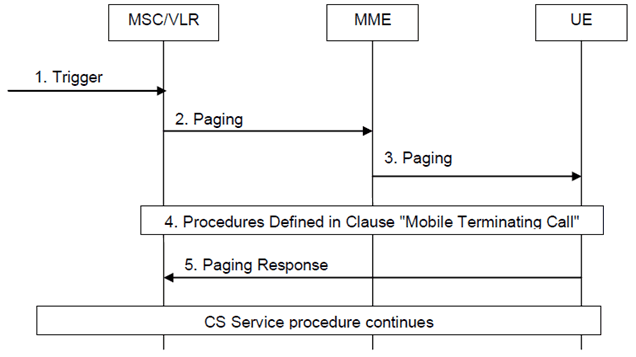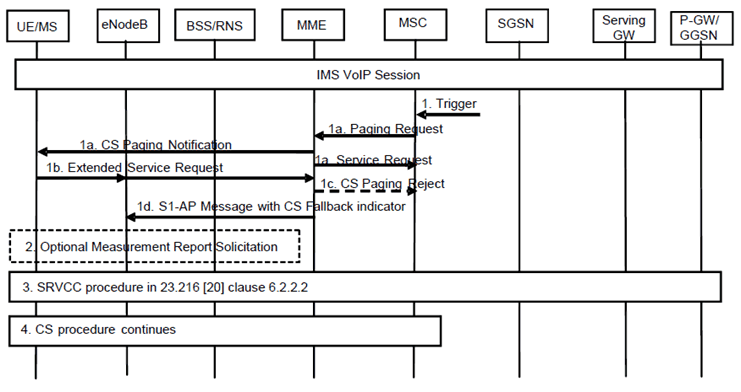Content for TS 23.272 Word version: 17.0.0
1…
4…
5…
5.4…
6…
6.3
6.4…
7…
7.3
7.4…
7.5a…
8…
8.2.4a…
8.3…
8.4…
B…
B.2…
B.2.2…
B.2.3a…
B.2.3a.4…
B.2.4…
B.3…
C…
C.8…
8.4 Other CS Services
8.4.0 General
8.4.1 Mobile-Initiated CS Services
8.4.2 NW-Initiated CS Services
8.4.3 Returning back to E-UTRAN
...
...
8.4 Other CS Services p. 66
8.4.0 General |R9| p. 66
The procedures specified in this clause apply when the UE is EPS/IMSI attached and the CS domain is chosen by the UE and/or the home PLMN to deliver other types of CS services, i.e. services not covered explicitly in previous clauses, such as Call Independent Supplementary Services, real time end-to-end facsimile group 3 services, TS 23.146, etc.
8.4.1 Mobile-Initiated CS Services p. 66
8.4.1.1 Mobile-Initiated CS Services if UE is not in IMS VoIP session |R11| p. 66
When UE is in active mode, UE and the network follow the procedure in clause 6.2 "Mobile Originating Call in Active Mode". After UE changes its RAT from E-UTRAN to UTRAN/GERAN, it performs Mobile Initiated CS procedures relevant to the initiated CS service, e.g. Call Independent Supplementary Service procedure as specified in TS 24.010, real time end-to-end facsimile group 3 procedure as specified in TS 23.146, etc.
When UE is in active mode and network initiates NACC procedure, then UE and the network follow the procedure in clause 6.3 "Mobile Originating Call in Active Mode No PS HO Support in GERAN". After UE changes its RAT from E-UTRAN to UTRAN/GERAN, it performs Mobile-Initiated CS procedures relevant to the initiated CS service, e.g. Supplementary Service procedure as specified in TS 24.010, real time end-to-end facsimile group 3 procedure as specified in TS 23.146, etc.
When UE is in idle mode, UE and the network follows the procedure in clause 6.4. After UE changes its RAT from E-UTRAN to UTRAN/GERAN, it performs Mobile-Initiated CS procedures relevant to the initiated CS service, e.g. Supplementary Services procedure as specified in specifications such as TS 23.090, real time end-to-end facsimile group 3 procedure as specified in TS 23.146, etc.
MSC may set a timer upon reception of the Call Independent Supplementary Service operation and maintain the RRC connection until the timer expires. Upon reception of a subsequent CISS operation the timer is re-set. This reduces the risk that the UE is returned to the E-UTRAN and then back to UTRAN/GERAN for each subsequent CISS operation.
8.4.1.2 Mobile-Initiated CS Services while UE is in IMS VoIP session |R11| p. 67
When the UE is in active mode with an IMS VoIP session and if the UE supports SRVCC procedures, the procedure for Mobile-Initiated CS Services while UE is in IMS VoIP session is the same as for "NW-Initiated CS Services while UE is in IMS VoIP session" in clause 8.4.2.2 from step 1b (Extended Service Request), with the difference that the Extended Service Request is for mobile originating CS Fallback.
8.4.2 NW-Initiated CS Services p. 67
8.4.2.1 NW-Initiated CS Services if UE is not in IMS VoIP session |R11| p. 67

Step 1.
MSC/VLR receives a trigger for a NW-Initiated CS procedure.
Step 2.
MSC/VLR sends Paging message to MME. For call independent supplementary service, the Paging message may include the SS service ID.
Step 3.
If the MME did not return the "SMS-only" indication to the UE during Attach or Combined TA/LA Update procedures, the MME sends Paging (parameters as specified in TS 23.401, CN Domain Indicator) message to UE. For call independent supplementary service the Paging message may include the SS service ID. SS service ID is used to indicate that a call independent supplementary service is triggered. The SS service ID is only included in CS Page if UE is in active mode.
If the MME returned the "SMS-only" indication to the UE during Attach or Combined TA/LA Update procedures, the MME shall not send the Paging to the UE, and the MME sends CS Paging Reject towards MSC to stop CS Paging procedure and this CSFB procedure stops.
Step 4.
The mobile terminating call procedure then takes place as specified in clause 7 "Mobile Terminating Call Procedure".
Step 5.
Once the paging is successfully returned to MSC, the applicable CS procedures continues, e.g. for Supplementary Service as specified in specifications such as TS 23.090.
8.4.2.2 NW-Initiated CS Services while UE is in IMS VoIP session |R11| p. 68

Figure 8.4.2.2-1: NW-Initiated CS Service procedure while UE is in IMS VoIP session
(⇒ copy of original 3GPP image)
(⇒ copy of original 3GPP image)
Step 1.
When SRVCC capable UE is in active mode with an IMS VoIP session but the network does not support SRVCC, MME sends Paging Reject towards MSC and this CSFB procedure stops. This is based on the bearer information at MME indicating UE has IMS VoIP session, i.e. EPS bearer with QCI=1.
MSC/VLR receives a trigger for a NW-Initiated CS procedure.
Step 1a.
The MSC responds by sending a Paging Request to the MME over a SGs interface. For call independent supplementary service, the Paging message may include the SS service ID. The MME has an established S1 connection for IMS VoIP session.
If the MME did not return the "SMS-only" indication to the UE during Attach or Combined TA/LA Update procedures, the MME sends Paging (parameters as specified in TS 23.401, CN Domain Indicator) message to UE. For call independent supplementary service the Paging message may include the SS service ID. SS service ID is used to indicate the type of the supplementary service to the UE. The SS service ID is only included in CS Page if UE is in active mode.
If the MME returned the "SMS-only" indication to the UE during Attach or Combined TA/LA Update procedures, the MME shall not send the Paging to the UE, and the MME sends CS Paging Reject towards MSC to stop CS Paging procedure and this CSFB procedure stops.
The eNodeB forwards the paging message to the UE.
Step 1b.
UE sends an Extended Service Request (Reject or Accept) message to the MME for mobile terminating CS Fallback. The Extended Service Request message is encapsulated in RRC and S1-AP messages.
Step 1c.
Upon receiving the Extended Service Request (Reject) for mobile terminating CS Fallback, the MME sends Paging Reject towards MSC to stop CS Paging procedure and this CSFB procedure stops. Corresponding error handling is returned to the GMLC as specified in TS 23.271.
Step 1d.
MME sends an S1-AP Request message to eNodeB that includes the UE Radio Capabilities and a CS Fallback Indicator. This message indicates to the eNodeB that the UE should be moved to UTRAN/GERAN.
Step 1e.
The eNodeB shall reply with S1-AP Response message.
Step 2.
These steps are performed as defined in clause 7.3 for PS handover supported case and clause 7.4 for No PS handover supported case.
Step 3.
Based on UE measurement reports and CS Fallback Indicator in step 1d, the source E-UTRAN decides to trigger an SRVCC handover to UTRAN/GERAN. Continuous SRVCC procedures as specified in clause 6.2.2.2 of TS 23.216 for PS handover supported case and clause 6.2.2.1A of TS 23.216 for No PS HO supported case are performed.
Step 4.
After receiving Relocation/Handover Complete message from the RNS/BSS in step 3, the applicable CS procedure continues, e.g. for Supplementary Service as specified in specifications such as TS 23.090.
8.4.3 Returning back to E-UTRAN p. 69
Once CS service ends in CS domain, existing mechanisms as specified in TS 23.401 can be used to move the UE to E-UTRAN, no specific CS Fallback mechanisms are needed.
During the release of an RR connection the MSC should indicate to GERAN/UTRAN that the RR connection (for call or CISS or LCS) was established as a result of CS fallback. GERAN and UTRAN may use the indication to determine which of the existing mechanisms that should be used to move the UE to E-UTRAN.
When configured to support the return to the last used PLMN after CSFB, after a successful setup of an RR connection or during the release of the UTRAN RR connection, the MSC shall further indicate to GERAN/UTRAN the last used LTE PLMN ID. GERAN and UTRAN shall take the last used LTE PLMN ID into account when selecting the target cell in PS handover to E-UTRAN or when selecting the dedicated target frequency list for idle mode mobility to E-UTRAN in RR Connection Release procedure.